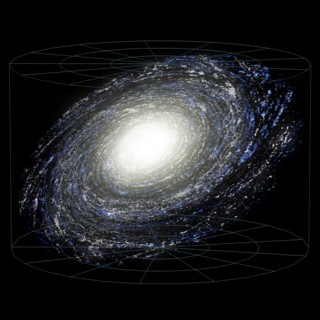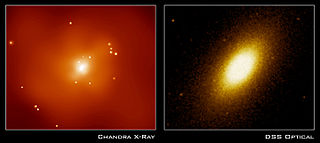Related Research Articles
The study of galaxy formation and evolution is concerned with the processes that formed a heterogeneous universe from a homogeneous beginning, the formation of the first galaxies, the way galaxies change over time, and the processes that have generated the variety of structures observed in nearby galaxies. Galaxy formation is hypothesized to occur from structure formation theories, as a result of tiny quantum fluctuations in the aftermath of the Big Bang. The simplest model in general agreement with observed phenomena is the Lambda-CDM model—that is, that clustering and merging allows galaxies to accumulate mass, determining both their shape and structure. Hydrodynamics simulation, which simulates both baryons and dark matter, is widely used to study galaxy formation and evolution.

A globular cluster is a spheroidal conglomeration of stars that is bound together by gravity, with a higher concentration of stars towards their centers. They can contain anywhere from tens of thousands to many millions of member stars, all orbiting in a stable, compact formation. Globular clusters are similar in form to dwarf spheroidal galaxies, and the distinction between the two is not always clear. Their name is derived from Latin globulus. Globular clusters are occasionally known simply as "globulars".

The Andromeda Galaxy is a barred spiral galaxy and is the nearest major galaxy to the Milky Way. It was originally named the Andromeda Nebula and is cataloged as Messier 31, M31, and NGC 224. Andromeda has a diameter of about 46.56 kiloparsecs and is approximately 765 kpc from Earth. The galaxy's name stems from the area of Earth's sky in which it appears, the constellation of Andromeda, which itself is named after the princess who was the wife of Perseus in Greek mythology.

Messier 107 or M107, also known as NGC 6171 or the Crucifix Cluster, is a very loose globular cluster in a very mildly southern part of the sky close to the equator in Ophiuchus, and is the last such object in the Messier Catalogue.

In astronomy, a galactic bulge is a tightly packed group of stars within a larger star formation. The term almost exclusively refers to the central group of stars found in most spiral galaxies. Bulges were historically thought to be elliptical galaxies that happened to have a disk of stars around them, but high-resolution images using the Hubble Space Telescope have revealed that many bulges lie at the heart of a spiral galaxy. It is now thought that there are at least two types of bulges: bulges that are like ellipticals and bulges that are like spiral galaxies.

Messier 53 is a globular cluster in the Coma Berenices constellation. It was discovered by Johann Elert Bode in 1775. M53 is one of the more outlying globular clusters, being about 60,000 light-years (18.4 kpc) light-years away from the Galactic Center, and almost the same distance from the Solar System. The cluster has a core radius (rc) of 2.18 pc, a half-light radius (rh) of 5.84 pc, and a tidal radius (rtr) of 239.9 pc.

The Monoceros Ring(monoceros: Greek for 'unicorn') is a long, complex, ring of stars that wraps around the Milky Way three times. This is proposed to consist of a stellar stream torn from the Canis Major Dwarf Galaxy by tidal forces as part of the process of merging with the Milky Way over a period of billions of years, although this view has long been disputed. The ring contains 100 million solar masses and is 200,000 light years long.

The Milky Way is the galaxy that includes the Solar System, with the name describing the galaxy's appearance from Earth: a hazy band of light seen in the night sky formed from stars that cannot be individually distinguished by the naked eye. The term Milky Way is a translation of the Latin via lactea, from the Greek γαλαξίας κύκλος, meaning "milky circle". From Earth, the Milky Way appears as a band because its disk-shaped structure is viewed from within. Galileo Galilei first resolved the band of light into individual stars with his telescope in 1610. Until the early 1920s, most astronomers thought that the Milky Way contained all the stars in the Universe. Following the 1920 Great Debate between the astronomers Harlow Shapley and Heber Doust Curtis, observations by Edwin Hubble showed that the Milky Way is just one of many galaxies.
The Milky Way has several smaller galaxies gravitationally bound to it, as part of the Milky Way subgroup, which is part of the local galaxy cluster, the Local Group.

In astronomy, the initial mass function (IMF) is an empirical function that describes the initial distribution of masses for a population of stars during star formation. IMF not only describes the formation and evolution of individual stars, it also serves as an important link that describes the formation and evolution of galaxies.

NGC 5986 is a globular cluster of stars in the southern constellation of Lupus, located at a distance of approximately 34 kilolight-years from the Sun. It was discovered by Scottish astronomer James Dunlop on May 10, 1826. John L. E. Dreyer described it as, "a remarkable object, a globular cluster, very bright, large, round, very gradually brighter middle, stars of 13th to 15th magnitude". Its prograde–retrograde orbit through the Milky Way galaxy is considered irregular and highly eccentric. It has a mean heliocentric radial velocity of +100 km/s. The galacto-centric distance is 17 kly (5.2 kpc), which puts it in the galaxy's inner halo.

NGC 6934 is a globular cluster of stars in the northern constellation of Delphinus, about 52 kilolight-years distant from the Sun. It was discovered by the German-born astronomer William Herschel on 24 September 1785. The cluster is following a highly eccentric orbit through the Milky Way along an orbital plane that is inclined by 73° to the galactic plane. It may share a common dynamic origin with NGC 5466. As of 2018, it has been poorly studied.
Segue 1 is a dwarf spheroidal galaxy or globular cluster situated in the Leo constellation and discovered in 2006 by Sloan Digital Sky Survey. It is located at a distance of about 23 kpc from the Sun and moves away from the Sun with the velocity of about 206 km/s. Segue 1 has a noticeably elongated shape with the half-light radius of about 30 pc. This elongation may be caused by the tidal forces acting from the Milky Way galaxy if Segue 1 is being tidally disrupted now.

In astronomy, stellar kinematics is the observational study or measurement of the kinematics or motions of stars through space.

NGC 5286 is a globular cluster of stars located some 35,900 light years away in the constellation Centaurus. At this distance, the light from the cluster has undergone reddening from interstellar gas and dust equal to E(B – V) = 0.24 magnitude in the UBV photometric system. The cluster lies 4 arc-minutes north of the naked-eye star M Centauri. It was discovered by Scottish astronomer James Dunlop, active in Australia, and listed in his 1827 catalog.

The thick disk is one of the structural components of about 2/3 of all disk galaxies, including the Milky Way. It was discovered first in external edge-on galaxies. Soon after, it was proposed as a distinct galactic structure in the Milky Way, different from the thin disk and the halo in the 1983 article by Gilmore & Reid. It is supposed to dominate the stellar number density between 1 and 5 kiloparsecs above the galactic plane and, in the solar neighborhood, is composed almost exclusively of older stars. Its stellar chemistry and stellar kinematics are also said to set it apart from the thin disk. Compared to the thin disk, thick disk stars typically have significantly lower levels of metals—that is, the abundance of elements other than hydrogen and helium.
In astronomy, the Sagittarius Stream is a long, complex structure made of stars that wrap around the Milky Way galaxy in an orbit that nearly crosses the galactic poles. It consists of tidally stripped stars from the Sagittarius Dwarf Elliptical Galaxy, resulting from the process of merging with the Milky Way over a period of billions of years.

NGC 720 is an elliptical galaxy located in the constellation Cetus. It is located at a distance of circa 80 million light years from Earth, which, given its apparent dimensions, means that NGC 720 is about 110,000 light years across. It was discovered by William Herschel on October 3, 1785. The galaxy is included in the Herschel 400 Catalogue. It lies about three and a half degrees south and slightly east from zeta Ceti.
References
- ↑ Kinman, T. D.; Wirtanen, C. A.; Janes, K. A. (July 1966). "An RR Lyrae Star Survey with the Lick 20-INCH Astrograph IV. a Survey of Three Fields Near the North Galactic Pole". The Astrophysical Journal Supplement Series. 13: 379. Bibcode:1966ApJS...13..379K. doi:10.1086/190140.
- ↑ Hartwick, F. D. A. (1987). "The structure of the Galactic halo". Proceedings of the NATO Advanced Study Institute. 207: 281–290. Bibcode:1987ASIC..207..281H.
- ↑ Newberg, Heidi Jo; Yanny, Brian (1 October 2006). "The Milky Way's stellar halo - lumpy or triaxial?". Journal of Physics: Conference Series. 47 (1): 195–204. arXiv: astro-ph/0507671 . Bibcode:2006JPhCS..47..195N. doi:10.1088/1742-6596/47/1/024. S2CID 250666026.
- ↑ Jurić, Mario; Ivezić, Željko; Brooks, Alyson (February 2008). "The Milky Way Tomography with SDSS. I. Stellar Number Density Distribution". The Astrophysical Journal. 673 (2): 864–914. arXiv: astro-ph/0510520 . Bibcode:2008ApJ...673..864J. doi:10.1086/523619. S2CID 11935446.
- ↑ Deason, A. J.; Belokurov, V.; Evans, N. W. (1 October 2011). "The Milky Way stellar halo out to 40 kpc: squashed, broken but smooth". Monthly Notices of the Royal Astronomical Society. 416 (4): 2903–2915. arXiv: 1104.3220 . Bibcode:2011MNRAS.416.2903D. doi:10.1111/j.1365-2966.2011.19237.x. S2CID 119117899.
- ↑ Monachesi, Antonela; Bell, Eric F.; Radburn-Smith, David J.; Bailin, Jeremy (4 February 2016). "The GHOSTS survey – II. The diversity of halo colour and metallicity profiles of massive disc galaxies". Monthly Notices of the Royal Astronomical Society. 457 (2): 1419–1446. arXiv: 1507.06657 . Bibcode:2016MNRAS.457.1419M. doi:10.1093/mnras/stv2987.
- ↑ Trujillo, Ignacio; Bakos, Judit (2013-05-11). "Stellar haloes of disc galaxies at z ∼ 1". Monthly Notices of the Royal Astronomical Society. 431 (2): 1121–1135. arXiv: 1207.7023 . Bibcode:2013MNRAS.431.1121T. doi:10.1093/mnras/stt232. ISSN 0035-8711.
- ↑ Helmi, Amina (22 April 2008). "The stellar halo of the Galaxy". The Astronomy and Astrophysics Review. 15 (3): 145–188. arXiv: 0804.0019 . Bibcode:2008A&ARv..15..145H. doi:10.1007/s00159-008-0009-6. S2CID 2137586.
- ↑ Ibata, Rodrigo; Gibson, Brad (April 2007). "The Ghosts of Galaxies Past". Scientific American. 296 (4): 40–45. Bibcode:2007SciAm.296d..40I. doi:10.1038/scientificamerican0407-40. PMID 17479629.
- ↑ Gilbert, Karoline M.; Kalirai, Jason S.; Guhathakurta, Puragra; Beaton, Rachael L. (10 November 2014). "Global Properties of M31's Stellar Halo from the Splash Survey. Ii. Metallicity Profile". The Astrophysical Journal. 796 (2): 76. arXiv: 1409.3843 . Bibcode:2014ApJ...796...76G. doi:10.1088/0004-637X/796/2/76. S2CID 33355790.
- ↑ McCarthy, I. G.; Font, A. S.; Crain, R. A.; Deason, A. J. (1 March 2012). "Global structure and kinematics of stellar haloes in cosmological hydrodynamic simulations". Monthly Notices of the Royal Astronomical Society. 420 (3): 2245–2262. arXiv: 1111.1747 . Bibcode:2012MNRAS.420.2245M. doi:10.1111/j.1365-2966.2011.20189.x. S2CID 53679383.
- ↑ Beers, Timothy C.; Carollo, Daniela; Ivezić, Željko; An, Deokkeun (10 February 2012). "The Case for the Dual Halo of the Milky Way". The Astrophysical Journal. 746 (1): 34. arXiv: 1104.2513 . Bibcode:2012ApJ...746...34B. doi:10.1088/0004-637X/746/1/34. S2CID 51354794.
- ↑ Schönrich, Ralph; Asplund, Martin; Casagrande, Luca (1 May 2014). "Does SEGUE/SDSS indicate a dual Galactic halo?". The Astrophysical Journal. 786 (1): 7. arXiv: 1403.0937 . Bibcode:2014ApJ...786....7S. doi:10.1088/0004-637X/786/1/7. S2CID 118357068.
- ↑ Cooper, A.P.; Cole, S.; Frenk, C.S. (1 August 2010). "Galactic stellar haloes in the CDM model". Monthly Notices of the Royal Astronomical Society. 406 (2): 744–766. arXiv: 0910.3211 . Bibcode:2010MNRAS.406..744C. doi:10.1111/j.1365-2966.2010.16740.x. S2CID 43143695.